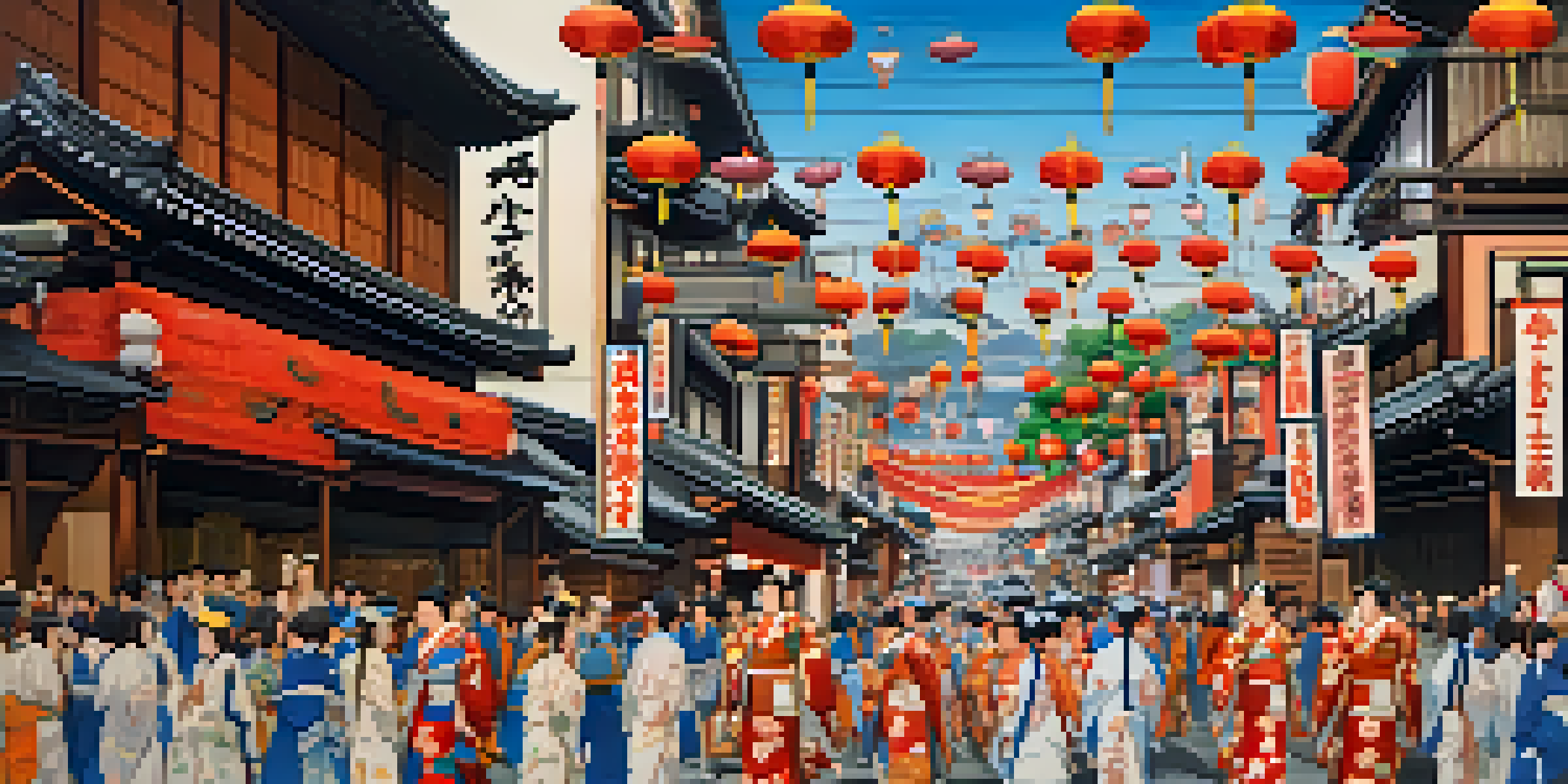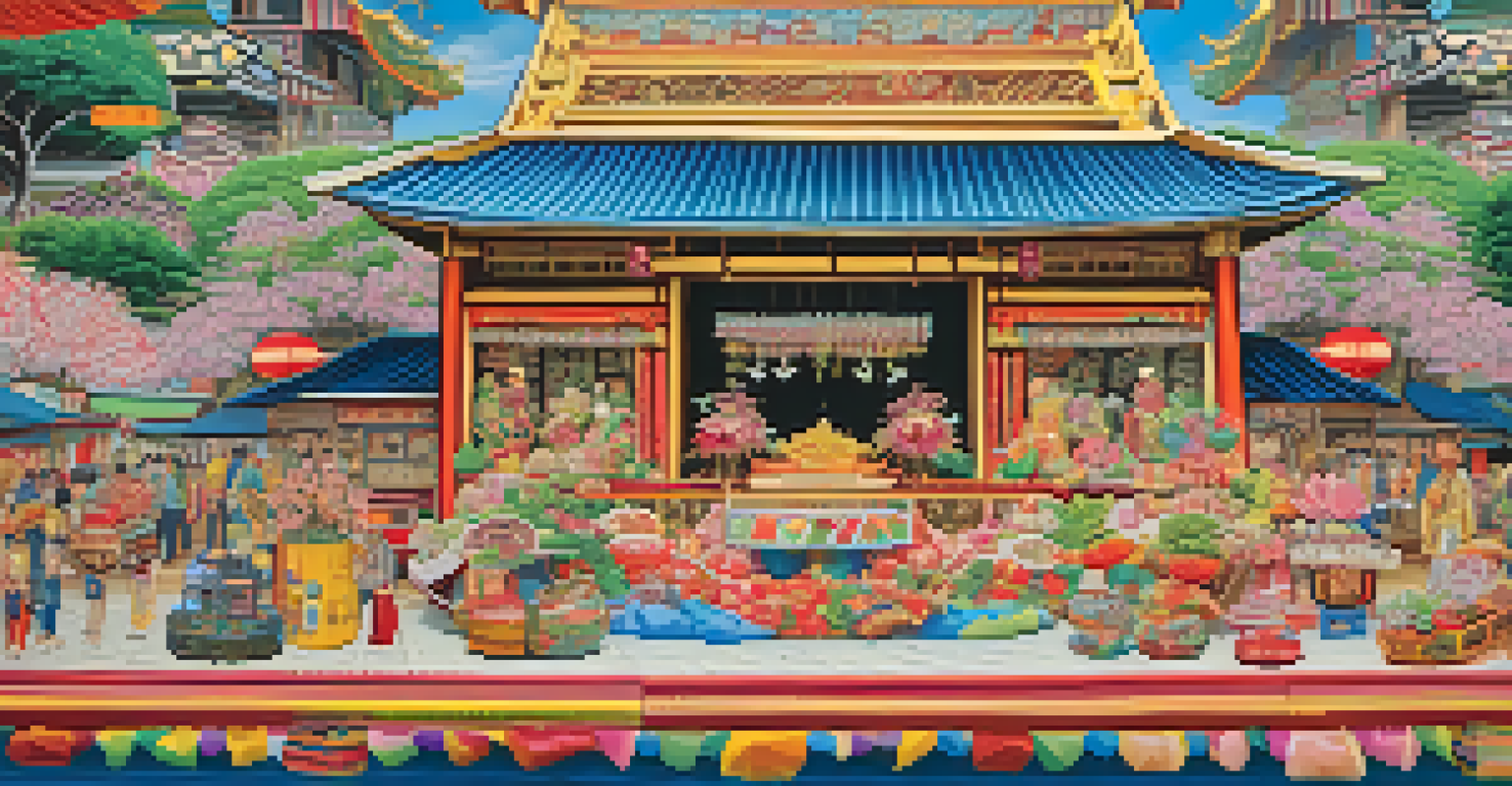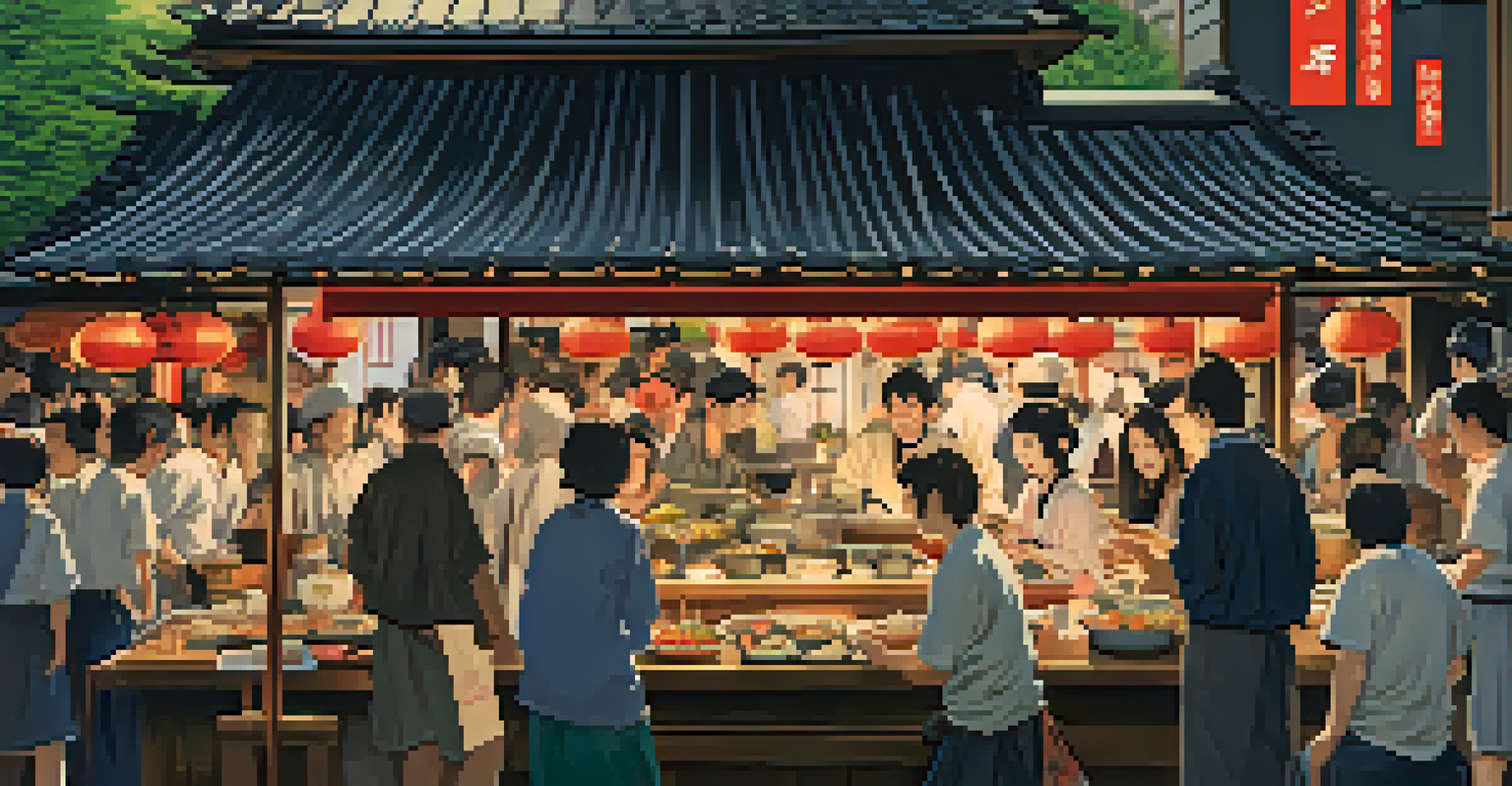Gion Matsuri: A Deep Dive into Kyoto's Historic Festival

A Brief History of Gion Matsuri's Origins
Gion Matsuri, held every July in Kyoto, traces its roots back to the 9th century. Originally a purification ritual to appease the gods during a plague, it has evolved into one of Japan's most celebrated festivals. The name 'Gion' comes from the Gion Shrine, which plays a central role in the festivities, highlighting the festival's deep spiritual connection to the local community.
Festivals, like Gion Matsuri, are a reminder of the importance of community and the shared heritage that binds us together.
Over the centuries, Gion Matsuri has transformed significantly, incorporating various cultural elements and traditions. For instance, the elaborate floats, known as 'yamaboko,' were first introduced in the 16th century, showcasing the artistry and craftsmanship of Kyoto's artisans. These floats not only serve as beautiful symbols of the festival but also represent the rich history of the city itself.
Today, Gion Matsuri is a vibrant display of tradition, creativity, and community spirit. It attracts both locals and tourists alike, all eager to witness the unique blend of history and celebration that defines this remarkable festival. The enduring legacy of Gion Matsuri underscores its importance in Kyoto's cultural landscape.
The Procession of Yamaboko: A Spectacle to Behold
One of the most striking features of Gion Matsuri is the procession of yamaboko, towering floats that are both intricate and awe-inspiring. These floats, some reaching up to 25 meters in height, are meticulously crafted and decorated, often adorned with elaborate tapestries and traditional motifs. The procession is a sight to behold, with each float representing different neighborhoods in Kyoto, showcasing local pride and craftsmanship.

The highlight of the float parade occurs on July 17th, known as Yamaboko Junko, when the floats are paraded through the streets. As they glide through the city, the floats are accompanied by musicians and performers in traditional attire, creating an electric atmosphere. This celebration is not just about visual splendor; it fosters a sense of unity and camaraderie among the participants and spectators alike.
Cultural Heritage of Gion Matsuri
Gion Matsuri, rooted in 9th-century purification rituals, showcases Kyoto's rich history and community spirit through elaborate floats and traditional ceremonies.
Participating in the procession is a labor of love for many locals, as each neighborhood takes pride in their float's history and design. The dedication and effort put into these floats reflect the community's commitment to preserving their cultural heritage. For anyone attending Gion Matsuri, witnessing the yamaboko procession is a must, as it truly captures the essence of this historic festival.
Traditional Rituals: Connecting Past and Present
At the heart of Gion Matsuri lies a series of traditional rituals that connect the past with the present. Among these, the ceremonial purification rites at the Gion Shrine are particularly significant, marking the festival's spiritual foundation. These rituals serve to honor the deities and seek blessings for the community, reinforcing the festival's deep-rooted cultural significance.
Food is not just about sustenance; it is an expression of culture and tradition, especially evident during festivals like Gion Matsuri.
Another important ritual is the 'Kamo River Waterside Ceremony,' where participants offer prayers and blessings to the river, symbolizing the importance of water in sustaining life. This ceremony highlights the connection between nature and the community's well-being, reminding everyone of the harmony that exists between them. Such practices illustrate how Gion Matsuri not only celebrates the past but also addresses contemporary issues.
Engaging in these rituals allows participants to reflect on their cultural heritage and fosters a sense of belonging. For many, it's a chance to reconnect with their roots and honor the traditions passed down through generations. This intertwining of history and spirituality is what sets Gion Matsuri apart, making it a deeply meaningful experience.
The Role of Local Communities in Gion Matsuri
Gion Matsuri is not just a festival; it is a community event that involves countless local participants. From the craftsmen who build the floats to the families who prepare traditional food for visitors, the entire community rallies together to make the festival a success. This collective effort fosters a strong sense of camaraderie and pride among residents, reinforcing their connection to the festival.
Each neighborhood in Kyoto has its own unique role in the festivities, often competing to create the most impressive float. This friendly rivalry not only enhances the quality of the floats but also encourages creativity and innovation among the participants. As a result, each float becomes a representation of the neighborhood's identity and history, making the festival a true celebration of local culture.
Community Involvement in the Festival
The festival thrives on local participation, with neighborhoods competing to create impressive floats, fostering a sense of camaraderie and pride among residents.
Moreover, Gion Matsuri provides an opportunity for younger generations to learn about their cultural heritage and participate in age-old traditions. This transmission of knowledge ensures that the festival remains relevant and vibrant, keeping the spirit of Gion Matsuri alive for future generations. The festival is a testament to the power of community, showcasing how collective effort can create something truly extraordinary.
Culinary Delights: Food at Gion Matsuri
Food is an integral part of Gion Matsuri, with countless stalls and vendors offering a variety of local specialties. From savory yakitori to sweet dango, the festival provides a feast for the senses. Visitors can indulge in traditional Kyoto cuisine, experiencing flavors that have been honed over centuries, making the festival a gastronomic adventure as well as a cultural one.
One of the most popular dishes during the festival is 'yudofu,' or boiled tofu, which is a simple yet exquisite representation of Kyoto's culinary philosophy. This dish highlights the importance of fresh, seasonal ingredients and showcases the delicate flavors that define the region's cuisine. Sampling these local dishes while surrounded by the festive atmosphere truly enhances the overall experience.
Additionally, many food stalls incorporate elements of the festival's traditions, creating unique dishes that celebrate the occasion. For instance, some vendors offer special sweets that are shaped like the floats or feature motifs from the festival. This creativity not only makes the food more enjoyable but also deepens the connection between culinary traditions and the festivities.
Cultural Events: Art and Performance During the Festival
Gion Matsuri is not limited to floats and food; it also showcases a variety of cultural events that enrich the festival experience. Traditional performances, such as 'Gion Bayashi,' a type of folk music, fill the air with lively tunes, while theatrical presentations offer glimpses into Kyoto's rich artistic history. These performances create a vibrant atmosphere that captivates both locals and tourists alike.
Additionally, workshops and exhibitions are held throughout the festival, allowing visitors to engage with local artisans and learn about traditional crafts. From kimono-making to calligraphy, these interactive experiences provide a deeper understanding of Kyoto's cultural heritage. Participants often leave with newfound skills and a greater appreciation for the artistry involved in these crafts.
Culinary Delights Enhance Experience
Food stalls at Gion Matsuri offer a diverse array of traditional Kyoto dishes, allowing visitors to indulge in the region's culinary heritage while enjoying the festive atmosphere.
By blending various forms of art and performance, Gion Matsuri fosters a rich cultural exchange that resonates with everyone involved. Whether you’re watching a performance or trying your hand at a craft, the festival offers a unique opportunity to immerse yourself in Kyoto's artistic traditions. This emphasis on culture enhances the festival's appeal, making it a truly multifaceted celebration.
Planning Your Visit: Tips for Experiencing Gion Matsuri
If you're planning to attend Gion Matsuri, timing is key. The festival spans the entire month of July, with the most significant events occurring from July 1st to July 17th. To fully experience the festivities, consider visiting during this peak time, when you can witness the vibrant processions, rituals, and cultural events that define the festival.
Accommodations can fill up quickly, so it's wise to book your stay in advance, especially if you want to be close to the action. Additionally, familiarizing yourself with public transportation options in Kyoto will help you navigate the city efficiently. The festival's popularity can lead to large crowds, so planning your travel around peak times can make your experience more enjoyable.

Finally, don't forget to immerse yourself in the local culture by trying the food, participating in workshops, and enjoying the performances. Gion Matsuri is not just about watching; it's about engaging with the community and embracing the spirit of the festival. By being an active participant, you’ll create lasting memories and deepen your connection to this historic celebration.